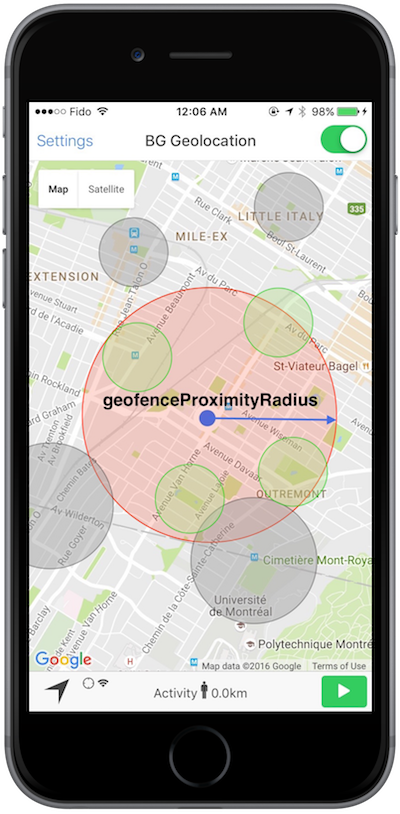The Background Geolocation contains powerful geofencing features that allow you to monitor any number of circular geofences you wish (thousands even), in spite of limits imposed by the native platform APIs (20 for iOS; 100 for Android).
The plugin achieves this by storing your geofences in its database, using a geospatial query to determine those geofences in proximity (@see config geofenceProximityRadius), activating only those geofences closest to the device's current location (according to limit imposed by the corresponding platform).
When the device is determined to be moving, the plugin periodically queries for geofences in proximity (eg. every minute) using the latest recorded location. This geospatial query is very fast, even with tens-of-thousands geofences in the database.
When a proximity-query detects a change in the list of monitored geofences, it will fire the geofenceschanged event, providing information about which geofences were activiated as well as those which were de-activiated.
The parameter provided to your event-handler takes the following form: ####@param {Array} on The list of geofences just activated. ####@param {Array off The list of geofences just de-activated
bgGeo.on('geofenceschange', function(event) {
var on = event.on; //<-- new geofences activiated.
var off = event.off; //<-- geofences that were de-activated.
// Create map circles
for (var n=0,len=on.length;n<len;n++) {
var geofence = on[n];
createGeofenceMarker(geofence)
}
// Remove map circles
for (var n=0,len=off.length;n<len;n++) {
var identifier = off[n];
removeGeofenceMarker(identifier);
}
});This event object provides only the changed geofences, those which just activated or de-activated.
When all geofences have been removed, the event object will provide an empty-array [] for both #on and #off keys, ie:
{
on: [{}, {}, ...], // <-- Entire geofence objects {}
off: ['identifier_foo', 'identifier_bar'] <-- just the identifiers
}bgGeo.on('geofenceschange', function(event) {
console.log("geofenceschange fired! ", event);
});
// calling remove geofences will cause the `geofenceschange` event to fire
bgGeo.removeGeofences();
=> geofenceschange fired! {on: [], off: []}Config: geofenceProximityRadius
@config geofenceProximityRadius {Integer} [1000] meters controls the circular area around the device's current position where geofences will be activated. As the device moves, the plugin periodically queries for geofences in proximity of the last-recorded location (default once-per-minute).
You can change the geofenceProximityRadius at run-time; the geofenceschange event will immediately fire if the monitored list-of-geofences changed as a result:
bgGeo.on('geofenceschange', function(event) {
console.log('geofenceschange fired! ', event);
});
bgGeo.setConfig({geofenceProximityRadius: 1000});
=> geofenceschange fired! {on: [{}, {}, ...], off: []}
bgGeo.setConfig({geofenceProximityRadius: 0});
=> geofenceschange fired! {on: [], off: ['foo', 'bar', ...]}
bgGeo.setConfig({geofenceProximityRadius: 0});
=> geofenceschange fired! {}The plugin is perfectly capable of monitoring large lists of geofences (tested with tens-of-thousands). However, when adding geofences, it's over 10 faster* to use the method addGeofences(plural) rather than looping and executing #addGeofence
var geofences = [...]; // <-- list of thousands-of-geofences
// 1. slow
for (var n=0,len-geofences.length;n<len;n++) {
bgGeo.addGeofence(geofences[n]);
}
// 2. Super fast.
bgGeo.addGeofences(geofences);If you render Circle markers on your map, you don't need to query your geofences with #getGeofences. This is particularly import when monitoring large lists of geofences.
Simply listen to the geofenceschange event and render Map markers accordingly.
